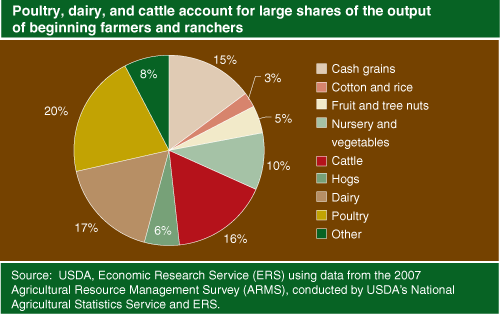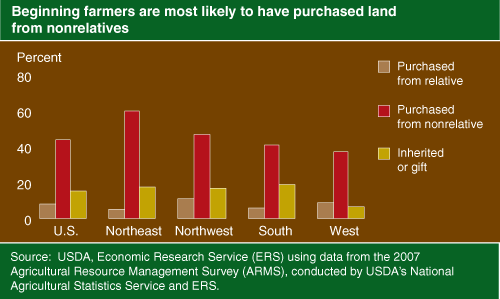Data Feature: Beginning Farmers and Ranchers: Who Are They?
- by Mary Ahearn
- 6/1/2009
Beginning farmers and ranchers face many challenges. High land prices and increasing equipment costs can serve as barriers to entry for those wishing to become farmers. The 2008 Farm Act requires USDA to develop several programs designed to provide additional support to beginning farmers, including increased conservation financial assistance and an expanded loan program.
But who are beginning farmers and how do they compare with established farmers? The current USDA definition of a beginning farmer is broad and applies to many farmers and ranchers for whom the goal of farming is largely to provide a household residence and investment opportunity, rather than to operate a commercially focused farm business. In 2007, about 30 percent of beginning farms did not report any production, compared with 19 percent of established farms.
Beginning Farmers Make Up a Quarter of U.S. Farm Operators
USDA currently defines a beginning farm as one operated by a farmer who has operated a farm or ranch for less than 10 years. Some beginning farms have more than one beginning farmer, and the 10-year requirement applies to all operators of the farm or ranch. Under this definition, 22 percent of U.S. farms were beginning farms in 2007. In the same period, there were over 750,000 farm operators with 10 years or less of experience, totaling 25 percent of all farm operators. Although they are not classified as beginning farms, some established farms also are operated jointly by established farmers with 10 years or less of experience.
| Category | Value |
|---|---|
| Number of beginning farms1 | 449,506 |
| Share of farms designated as beginning (percent) | 22 |
| Share of total value of U.S. production on beginning farms (percent) | 10 |
| Number of beginning farmers on beginning farms | 650,318 |
| Number of farmers with less experience on established farms2 | 101,253 |
| 1Beginning farm = All the principal operators (up to 3) have 10 years or less of experience. 2Farmers with 10 years or less experience operating farms with more experienced operators. They are eligible for Farm Credit Administration beginning farmer programs but not for USDA beginning farmer programs. Source: USDA, Economic Research Service (ERS) using data from the 2007 Agricultural Resource Management Survey (ARMS), conducted by USDA’s National Agricultural Statistics Service and ERS. |
|
Beginning Farms Are Smaller and Less Likely To Participate in Federal Farm Programs
Beginning farmers operate farms of all sizes but, on average, their farms are smaller than those of established farmers. The average beginning farmer in 2007 operated a farm that was less than half the size of that of the average established farmer’s—174 acres versus 461 acres. Beginning farms accounted for about 10 percent of the total value of U.S. production, though this varied significantly by agricultural commodity. In 2007, a larger number of beginning farms (and established farms) specialized in beef cattle than in any other commodity group. Beef cattle, dairy, and poultry products accounted for the greatest shares of value of production of beginning farmers and ranchers.
Beginning farmers are less likely to participate in Federal commodity and conservation assistance programs than are established farmers. The major Government commodity programs are tied to past or current production levels, and beginning farmers may not have any agricultural production history. However, nearly 30 percent of the beginning farms without production in 2007 had acres enrolled in USDA’s Conservation Reserve Program.
Startup Costs May Be a Barrier to Entry for Some
Farming commonly requires control over a significant amount of land and capital that may be difficult for would-be farmers and ranchers to obtain. One way that beginning farmers acquire assets is through inheritance. Since farmers, like the general population, are living longer, the delay in passing farms to their heirs may be a factor in the declining number of young farmers. Without an inheritance, farming may have to be postponed until sufficient resources have been accumulated to acquire necessary farm assets—a process that can take years.
Beginning farmers are less likely to operate rented land than are established farmers, and just as likely to own all of the land they operate. Beginning farmers, however, generally have less acreage and are more likely to carry debt on their land.
USDA’s 2006 Agricultural Resource Management Survey asked principal operators of beginning farms how they acquired the land they owned. Consistent with their debt loads, most beginning operators reported that they purchased land from a nonrelative. Gifts or inheritance was the second most common way beginning farmers acquired land, although shares varied by region.
Household Incomes Are Similar to Those of Other Farmers
In 2007, more than 60 percent of established farmers were over age 55, compared with 32 percent of beginning farmers. Nationwide, only 5 percent of principal operators of established farms are under the age of 35, versus 17 percent of beginning farmers. Like all farm operators, most beginning farm operators are White, non-Hispanic men. Beginning farmers, however, are more likely to be female, non-White, or Hispanic than are established farmers.
The average household income of beginning farmers in 2007 (from farm and off-farm sources) was 4 percent lower than that of established farm households ($87,004, compared with $90,866), and the average household incomes of both beginning and established farmers were significantly higher than that of the average U.S. household ($67,609). On average, beginning farmers and their households earn less income from their farm, but significantly more income from off-farm sources, than do more established operators and their households—although income sources vary significantly by size of farm.
This article is drawn from:
- Ahearn, M. & Newton, D. (2009). Beginning Farmers and Ranchers. U.S. Department of Agriculture, Economic Research Service. EIB-53.
You may also like:
- USDA’s Small Farms and Beginning Farmers and Ranchers Policy. (2006). USDA.




